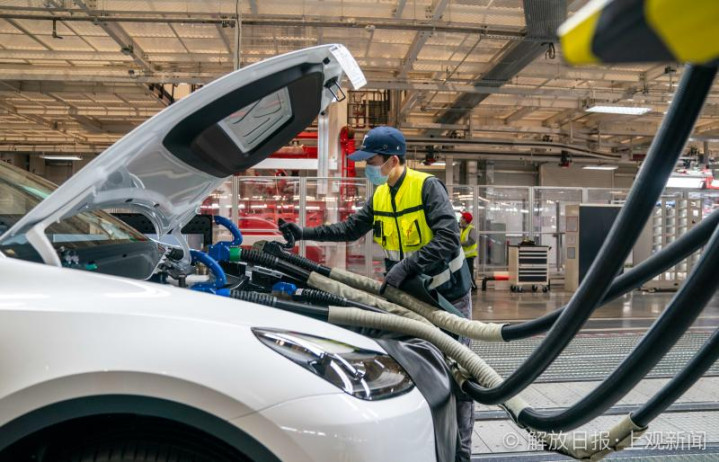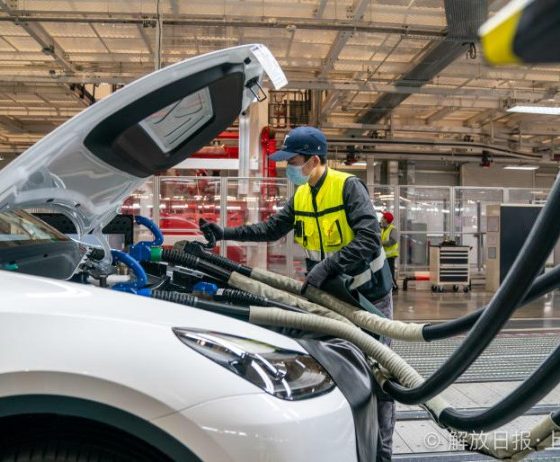Tesla China cleared the air regarding rumors of 4680 battery cells being used in vehicles built at the company’s Gigafactory Shanghai facility. According to the post, rumors have indicated that China-built Tesla vehicles are equipping the company’s 4680 cell chemistry, which was unveiled two years ago at Battery Day.
“In order to protect the interests of consumers, and in response to the special action of relevant departments to rectify rumors on the Internet, the following explanations are made in response to several recent rumors about Tesla China on the Internet,” Tesla’s Customer Support account wrote on Weibo yesterday.
It makes two points, the first being that no Tesla vehicles built in China use 4680 cells. “No matter what kind of battery is used, the products we provide to customers can meet Tesla’s strict product requirements and well meet vehicle performance indicators such as safety, battery life, and acceleration,” the account then wrote.
Additionally, the company clarified that “recent hype by some individuals…about Tesla ‘is about to change its model’” is a rumor that “deliberately misleads consumers.” Tesla then said that it would encourage people to point them in the direction of those who are starting these rumors so they can be held responsible.
“At the same time, prospective car owners are requested to pay attention to the changes in the delivery cycle and arrange the pick-up time reasonably,” the company also said. “Vehicles produced at Tesla’s Shanghai Gigafactory are usually exported to overseas markets in the first half of each quarter and supplied to the domestic market in the second half.”
The second part of that quote was revealed by CEO Elon Musk over a year ago as Gigafactory Shanghai was supplying Europe with cars as Gigafactory Berlin completed construction.
Elon Musk explains Tesla’s local and export strategy for factories like Giga Shanghai
Tesla has dealt with major misinformation campaigns against it in China for several years. After dealing with numerous fabricated stories, including several that put into question the effectiveness of Tesla’s braking systems, the company started suing those who made up stories about their vehicles failing.
For now, 4680 battery cells are being utilized for Model Y builds at Gigafactory Texas. Suppliers such as Panasonic have already started sending test samples of the cell to Tesla as they will eventually begin producing the battery for the electric automaker. Tesla produces the batteries in-house in California, but plans to begin manufacturing the cells at Gigafactory Texas by the end of this quarter.
Tesla China’s Weibo post was written as follows:
“In order to protect the interests of consumers, and in response to the special action of relevant departments to rectify rumors on the Internet, the following explanations are made in response to several recent rumors about Tesla China on the Internet:
1. Tesla models made in China currently do not use 4680 batteries in Plans for any new model batteries within. No matter what kind of battery is used, the products we provide to customers can meet Tesla’s strict product requirements and well meet vehicle performance indicators such as safety, battery life, and acceleration.
2. The recent hype by some individuals and self-media about “Tesla is about to change its model” is completely a rumor that deliberately misleads consumers. I hope everyone can provide us with clues, and we will hold the rumour-mongers accountable.
At the same time, prospective car owners are requested to pay attention to the changes in the delivery cycle and arrange the pick-up time reasonably. Vehicles produced at Tesla’s Shanghai Gigafactory are usually exported to overseas markets in the first half of each quarter and supplied to the domestic market in the second half.
We are very grateful that so many users choose Tesla because of their trust and love. We will continue to strive to provide customers with excellent products and user experience! Thanks again for your attention!”
I’d love to hear from you! If you have any comments, concerns, or questions, please email me at joey@teslarati.com. You can also reach me on Twitter @KlenderJoey, or if you have news tips, you can email us at tips@teslarati.com.

News
Tesla FSD fleet is nearing 7 billion total miles, including 2.5 billion city miles
As can be seen on Tesla’s official FSD webpage, vehicles equipped with the system have now navigated over 6.99 billion miles.

Tesla’s Full Self-Driving (Supervised) fleet is closing in on almost 7 billion total miles driven, as per data posted by the company on its official FSD webpage.
These figures hint at the massive scale of data fueling Tesla’s rapid FSD improvements, which have been quite notable as of late.
FSD mileage milestones
As can be seen on Tesla’s official FSD webpage, vehicles equipped with the system have now navigated over 6.99 billion miles. Tesla owner and avid FSD tester Whole Mars Catalog also shared a screenshot indicating that from the nearly 7 billion miles traveled by the FSD fleet, more than 2.5 billion miles were driven inside cities.
City miles are particularly valuable for complex urban scenarios like unprotected turns, pedestrian interactions, and traffic lights. This is also the difference-maker for FSD, as only complex solutions, such as Waymo’s self-driving taxis, operate similarly on inner-city streets. And even then, incidents such as the San Francisco blackouts have proven challenging for sensor-rich vehicles like Waymos.
Tesla’s data edge
Tesla has a number of advantages in the autonomous vehicle sector, one of which is the size of its fleet and the number of vehicles training FSD on real-world roads. Tesla’s nearly 7 billion FSD miles then allow the company to roll out updates that make its vehicles behave like they are being driven by experienced drivers, even if they are operating on their own.
So notable are Tesla’s improvements to FSD that NVIDIA Director of Robotics Jim Fan, after experiencing FSD v14, noted that the system is the first AI that passes what he described as a “Physical Turing Test.”
“Despite knowing exactly how robot learning works, I still find it magical watching the steering wheel turn by itself. First it feels surreal, next it becomes routine. Then, like the smartphone, taking it away actively hurts. This is how humanity gets rewired and glued to god-like technologies,” Fan wrote in a post on X.
News
Tesla starts showing how FSD will change lives in Europe
Local officials tested the system on narrow country roads and were impressed by FSD’s smooth, human-like driving, with some calling the service a game-changer for everyday life in areas that are far from urban centers.

Tesla has launched Europe’s first public shuttle service using Full Self-Driving (Supervised) in the rural Eifelkreis Bitburg-Prüm region of Germany, demonstrating how the technology can restore independence and mobility for people who struggle with limited transport options.
Local officials tested the system on narrow country roads and were impressed by FSD’s smooth, human-like driving, with some calling the service a game-changer for everyday life in areas that are far from urban centers.
Officials see real impact on rural residents
Arzfeld Mayor Johannes Kuhl and District Administrator Andreas Kruppert personally tested the Tesla shuttle service. This allowed them to see just how well FSD navigated winding lanes and rural roads confidently. Kruppert said, “Autonomous driving sounds like science fiction to many, but we simply see here that it works totally well in rural regions too.” Kuhl, for his part, also noted that FSD “feels like a very experienced driver.”
The pilot complements the area’s “Citizen Bus” program, which provides on-demand rides for elderly residents who can no longer drive themselves. Tesla Europe shared a video of a demonstration of the service, highlighting how FSD gives people their freedom back, even in places where public transport is not as prevalent.
What the Ministry for Economic Affairs and Transport says
Rhineland-Palatinate’s Minister Daniela Schmitt supported the project, praising the collaboration that made this “first of its kind in Europe” possible. As per the ministry, the rural rollout for the service shows FSD’s potential beyond major cities, and it delivers tangible benefits like grocery runs, doctor visits, and social connections for isolated residents.
“Reliable and flexible mobility is especially vital in rural areas. With the launch of a shuttle service using self-driving vehicles (FSD supervised) by Tesla in the Eifelkreis Bitburg-Prüm, an innovative pilot project is now getting underway that complements local community bus services. It is the first project of its kind in Europe.
“The result is a real gain for rural mobility: greater accessibility, more flexibility and tangible benefits for everyday life. A strong signal for innovation, cooperation and future-oriented mobility beyond urban centers,” the ministry wrote in a LinkedIn post.
News
Tesla China quietly posts Robotaxi-related job listing
Tesla China is currently seeking a Low Voltage Electrical Engineer to work on circuit board design for the company’s autonomous vehicles.

Tesla has posted a new job listing in Shanghai explicitly tied to its Robotaxi program, fueling speculation that the company is preparing to launch its dedicated autonomous ride-hailing service in China.
As noted in the listing, Tesla China is currently seeking a Low Voltage Electrical Engineer to work on circuit board design for the company’s autonomous vehicles.
Robotaxi-specific role
The listing, which was shared on social media platform X by industry watcher @tslaming, suggested that Tesla China is looking to fill the role urgently. The job listing itself specifically mentions that the person hired for the role will be working on the Low Voltage Hardware team, which would design the circuit boards that would serve as the nervous system of the Robotaxi.
Key tasks for the role, as indicated in the job listing, include collaboration with PCB layout, firmware, mechanical, program management, and validation teams, among other responsibilities. The role is based in Shanghai.
China Robotaxi launch
China represents a massive potential market for robotaxis, with its dense urban centers and supportive policies in select cities. Tesla has limited permission to roll out FSD in the country, though despite this, its vehicles have been hailed as among the best in the market when it comes to autonomous features. So far, at least, it appears that China supports Tesla’s FSD and Robotaxi rollout.
This was hinted at in November, when Tesla brought the Cybercab to the 8th China International Import Expo (CIIE) in Shanghai, marking the first time that the autonomous two-seater was brought to the Asia-Pacific region. The vehicle, despite not having a release date in China, received a significant amount of interest among the event’s attendees.










